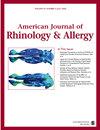Antimicrobial Prescription Patterns for Acute Sinusitis 2015–2022: A Comparison to Published Guidelines
IF 2.3
3区 医学
Q1 OTORHINOLARYNGOLOGY
引用次数: 0
Abstract
BackgroundAcute rhinosinusitis (ARS) is one of the most encountered conditions in primary care and otolaryngology clinics. However, little is known about how antibiotic prescription practices following a diagnosis of ARS compare to guidelines set forth by the American Academy of Otolaryngology in 2015.ObjectiveTo investigate the epidemiology of ARS and the corresponding antibiotic prescribing practices by physicians and compare to published guidelines.MethodsUsing the TriNetX Live database, we identified all patients diagnosed with ARS using the ICD10 code J01 between April 2015 and December 2022 across the state of Tennessee. After investigating the demographics of this cohort, we compared the first prescribed antibiotic within one day of ARS diagnosis to published guidelines. Antibiotics were grouped into their respective classes.ResultsOf 81 310 patients diagnosed with ARS identified in the specified time frame, 66% were Female, 49% were African American, 44% were White, and the mean age was 47 ± 20 years. The six most common initial antibiotics prescribed for ARS were erythromycins/macrolides [14 609 (25.8%)], amoxicillin/clavulanate [14 322 (25.3%)], amoxicillin [9300 (16.4%)], third generation cephalosporins [7733 (13.6%)], quinolones [3648 (6.4%)] and tetracyclines [2235 (3.9%)]. Of this cohort, 56 719 patients (69.8%) of patients were prescribed an antibiotic within one day of diagnosis.ConclusionDespite published guidelines recommending amoxicillin with or without clavulanic acid as first-line treatment for ARS, only 42.2% of prescribed antibiotics followed this guideline in our cohort. While accounting for patients with penicillin allergy, the second-most represented antibiotics were erythromycins/macrolides, which are specifically recommended against due to high rates of S. Pneumoniae resistance. Our results suggest that further investigation into the causes of erythromycin/macrolide prescriptions as first line treatment for ARS and practices at other institutions should be conducted. In addition, building awareness around published ARS guidelines for physicians may be useful in improving antibiotic stewardship in treatment of ARS.2015-2022 年急性鼻窦炎抗菌药处方模式:与已发布指南的比较
背景急性鼻窦炎(ARS)是初级保健和耳鼻喉科门诊中最常见的疾病之一。然而,人们对 ARS 诊断后的抗生素处方做法与美国耳鼻喉科学会 2015 年制定的指南的比较却知之甚少。Objective To investigate the epidemiology of ARS and the corresponding antibiotic prescribing practices by physicians and compare to published guidelines.Methods利用 TriNetX Live 数据库,我们确定了田纳西州在 2015 年 4 月至 2022 年 12 月期间使用 ICD10 代码 J01 诊断为 ARS 的所有患者。在调查了这批患者的人口统计学特征后,我们将 ARS 诊断后一天内首次处方的抗生素与已发布的指南进行了比较。结果 在规定时间内确诊的 81310 名 ARS 患者中,66% 为女性,49% 为非裔美国人,44% 为白人,平均年龄为 47 ± 20 岁。针对 ARS 最常见的六种处方抗生素是红霉素类/大环内酯类 [14 609 (25.8%)]、阿莫西林/克拉维酸[14 322 (25.3%)]、阿莫西林[9300 (16.4%)]、第三代头孢菌素[7733 (13.6%)]、喹诺酮类[3648 (6.4%)]和四环素类[2235 (3.9%)]。结论尽管已发布的指南推荐阿莫西林加或不加克拉维酸作为 ARS 的一线治疗,但在我们的队列中,只有 42.2% 的抗生素处方遵循了这一指南。考虑到青霉素过敏的患者,第二大抗生素是红霉素类/大环内酯类抗生素,由于肺炎链球菌的耐药率很高,因此特别建议不要使用这类抗生素。我们的研究结果表明,应进一步调查红霉素/大环内酯类抗生素作为 ARS 一线治疗处方的原因以及其他机构的做法。此外,提高医生对已发布的 ARS 指南的认识可能有助于改善 ARS 治疗中的抗生素管理。
本文章由计算机程序翻译,如有差异,请以英文原文为准。
求助全文
约1分钟内获得全文
求助全文
来源期刊
CiteScore
5.60
自引率
11.50%
发文量
82
审稿时长
4-8 weeks
期刊介绍:
The American Journal of Rhinology & Allergy is a peer-reviewed, scientific publication committed to expanding knowledge and publishing the best clinical and basic research within the fields of Rhinology & Allergy. Its focus is to publish information which contributes to improved quality of care for patients with nasal and sinus disorders. Its primary readership consists of otolaryngologists, allergists, and plastic surgeons. Published material includes peer-reviewed original research, clinical trials, and review articles.

 求助内容:
求助内容: 应助结果提醒方式:
应助结果提醒方式:


